Chapter 11: Cognitive Views of Learning: Memory and Information Processing
Learning Objectives
- Explain the cognitive model of memory, including sensory memory, working memory, and long-term memory.
- Describe how attention and rehearsal influence memory encoding and retrieval.
- Analyze how memory processing affects learning and instruction in the classroom.
Learning and Memory
The world is not static. It is dynamic and uncertain. Organisms compete and forage for scarce resources. To survive and thrive in this dynamic and uncertain environment while competing and foraging for scarce resources, we need to constantly adapt. Learning is what enables us to adapt to our environment – to succeed in uncertainty and among competition. Learning is acquiring information about the world. It involves exploring and making sense of our world.
Learning is a dynamic-over-time process that relies both on perceptual-short term processing and a short-to-long term establishment of learning in brain circuits. The constant retrieval and revision of learned concepts and skills, by means of review and experience, make the learnings more confident, durable and useful. This means that better acquisition is achieved when links to prior knowledge networks are more abundant. In other words, connections between what’s being learned and what’s been previously learned (and is relevant to the new learning) are established [1].
Memory is the system that retains our information about the world. Memory enhances our abilities to perform within our world [2]. In other words, learning can be thought of as the process of acquiring information about the world; and memory the process of retaining that information. Despite what many once thought, memory does not only relate to memorization[3]. Our aim is to clarify the terms, prevent misconceptions, and build bridges between the communities. In this case, the educational community typically thinks of memory as being the process of individually and repeatedly memorizing some kind of content. In this book, memory refers to the biological process and cognitive function in which categorical (concept) or skill learning is established within the circuits of the brain. Importantly, the ways of acquiring and consolidating such types of learning involve much more than repeated memorization. Educational strategies such as peer learning, the use of imagery, recall practice, and/or active learning involving retrieval and elaboration of learning are emphasized.[/footnote]. It is not only activated when needed to retrieve facts. Rather, our current understanding is that our memory systems hold facts, habits, skills, and thoughts – memory underlies all that we can do and think. It is critical to learning and living. We cannot learn without the involvement of our memory system [4].
To acquire information (e.g. learn) we have to be aware of the information and store the information – learning and memory are part of the same adaptive system. A system that enhances our ability to make accurate predictions for future actions. Thus, learning requires memory. So, it is learning (and memory) that enables us to adapt to our environment.
Critical Thinking
- How would you define learning from a cognitive perspective?
Types of Memory
The 3-stage (or multi-store) model of memory is a traditional yet prevailing model of memory. Yet, it should be noted that it is also a model that is still under development by cognitive (neuro)scientists. In the model, there are three types of memory: (1) Sensory memory, (2) Short-term (working) memory (STM), (3) Long-term memory (LTM).

Sensory Memory
Sensory memory is an automatic process related to perception. “Sensory memory refers to the automatic, transient storage of the sensory features of incoming stimuli for subsequent integration with previously presented stimuli and or recalled information” [5]. Our senses are constantly collecting information from our environment. This information is always available to us. When we move our attention (focus) or our attention is pulled to one of the senses, then we become consciously aware of that information. This awareness signals that sensory information has moved into our working memory (which is part of STM). At any time we can move our attention to any one of our senses to check the incoming information. Short-term memory (STM) “reflect faculties of the human mind that can hold a limited amount of information in a very accessible state temporarily” [6].
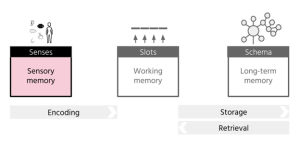
Working Memory
Working memory “is short-term maintenance of information in the absence of sensory input” [7]. “Working memory includes short-term memory and other processing mechanisms that help to make use of short-term memory” [8]. In other words, working memory is a part of short-term memory and refers to the information held in STM that we are actively keeping and manipulating.
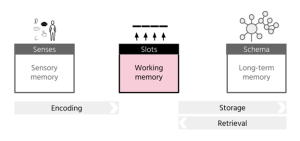
Long-term Memory
Long-term memory (LTM) is “a vast store of knowledge and a record of prior events” [9]. “Long- and short-term memory could differ in two fundamental ways, with only short-term memory demonstrating (1) temporal decay and (2) chunk capacity limits” [10]. In other words, LTM does not decay as quickly as STM nor is there a clear limit to how much information can be stored in LTM (see Table 11.1. for a comparison of STM and LTM characteristics).
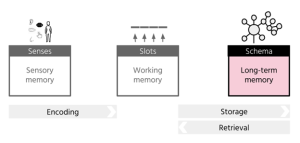
How do we know short-term and long-term memory are distinct? Scientists can selectively block long-term or short-term memory formation without affecting the other [11]. For example, by blocking the receptors for neurotransmitters, STM can be disrupted, but LTM is still updated. Also, STM can form by interfering with protein synthesis, but LTM are not created or updated. The distinction in types of memory is also evidenced by the different types of amnesia [12]. “Anterograde amnesia is a loss of the ability to create new memories after the event that caused amnesia, leading to a partial or complete inability to recall the recent past, while long-term memories from before the event remain intact. This contrasts with retrograde amnesia, where memories created before the event are lost while new memories can still be created” [13].
| Short-term (working) memory (STM) characteristics (Kukushkin & Carew, 2017; Eriksson et al., 2015; Kandel, Dudai, & Mayford, 2014) | Long-term memory (LTM) characteristics (Kukushkin & Carew, 2017; Eriksson et al., 2015; Kandel, Dudai, & Mayford, 2014) |
|---|---|
|
|
Critical Thinking
- How does understanding the distinctions between sensory memory, working memory, and long-term memory help you make more informed teaching decisions?
- Think about a time you couldn’t remember something you recently learned—was it an issue of attention, rehearsal, or both?
The Purpose of STM and LTM
Why does our brain have distinct short-term and long-term memory systems? STM and LTM serve different purposes in our survival system [14]. Short-term memory enables us to rapidly adapt to novel experiences. As we live in a dynamic and uncertain environment and regularly encounter novel information, this is a critical ability. On the other hand, long-term memory enables us to effectively preadapt to future experiences. “The biological utility of memory stems from its ability to modify future behavior based on past experience” [15]. We can identify patterns in our environment and improve the efficiency and effectiveness of our reactions [16].
Attention, Encoding, & Rehearsal
Sensory memory automatically gathers information from our senses, encoding it into a format the brain can interpret. Most of this information is ignored (e.g. unless we’re eating, we don’t pay much attention to the taste in our mouths). Encoding involves establishing temporary or short-term connections between new information and our prior knowledge networks (e.g. long-term memory). “Perceiving is remembering as much as sensing, and working memory is attention focused on an internal representation” [17]. Attention (what we focus on) is critical. If we don’t pay attention to something, it does not get encoded. It doesn’t enter our memory system so that we can consciously use the information. “The encoding of information into working memory is the result of interactions among selective attention processes and perceptual object representations that trigger related LTM object representations” [18].

The information that our attention falls on enters into short-term memory (STM) and is interpreted by our existing knowledge retrieved from long-term memory (LTM). This temporary connecting of information occurs in our working memory (WM) which is a part of STM and allows us to use or manipulate the information. “Information maintenance is considered to be the result of an interaction between basic building blocks of working memory, notably a selective attention process that operates on perceptual information and related long-term memory (LTM) representations” [19].
The information that is in our WM is what we are consciously aware of. However, WM is limited in capacity (i.e. studies have suggested between 4 to 9 slots) – so most of the information enters working memory temporarily and then leaves without being consolidated (e.g. stored) into LTM. Information that is used more (repeated) or has a high emotional value is prioritized for storage. In WM, our brain automatically retrieves our prior knowledge so that we can make these connections and try to make sense of the new information. This also means that anything new we learn, connects to something that is already there. “Storage of information is storage of relationships between objects or events” [20].
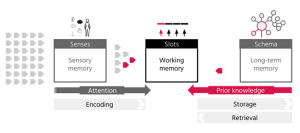
To maintain the temporary connections in working memory (STM), we have to rehearse (i.e. use or manipulate) the information which keeps it active. The more the information is used, the more likely it is to be prioritized for storage in LTM.
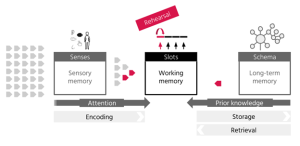
To consolidate or store the information in long-term memory, the temporary connections need to be made more permanent. Hippocampal replay plays an important role. “Patterns of neuronal activity present during learning in the hippocampus are replayed during sleep” [21]. Replay can also occur during periods of wakeful rest. We don’t have to sleep but we need to give our brains a break – an opportunity to repeat and consolidate information from recent experiences.
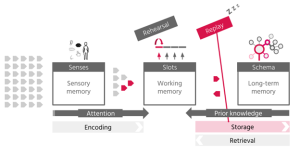
To be retrievable in the future, information held in WM has to be consolidated into LTM. LTM consists of connected networks or schema which we activate when we recall or retrieve information. Cues associated with the stored LTM are used to determine when to retrieve the stored information. Once a memory is retrieved, it becomes active and will be reconsolidated or updated as it is stored once again. Reconsolidation reveals that long-term memories are not permanent but rather they are changed whenever they are activated. Most of the information that enters our memory system is lost. In other words, it does not remain in our memory system in a manner in which we can consciously retrieve it – at least not for an extended period of time.
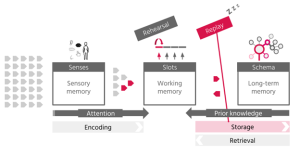
Critical Thinking
- Which memory-supportive strategies (e.g., retrieval practice, chunking, connecting to prior knowledge) do you plan to incorporate into your own learning? Why?
- Your teaching? teaching, and why?
Review & Practice
- What are the three main types of memory in the cognitive model?
- How does sensory memory differ from working memory?
- What is the primary role of long-term memory in learning?
- What is one key characteristic that distinguishes working memory from short-term memory?
- Why is it important to connect new information to prior knowledge?
- What role does attention play in memory encoding?
- How does rehearsal help maintain information in working memory?
- What happens to information that is not rehearsed or emotionally significant?
- Why is rehearsal critical to consolidation?
- What is meant by cognitive load?
- Why do connections to prior knowledge improve learning?
- How can retrieval practice strengthen memory?
- How can teachers reduce unnecessary cognitive load in instruction?
External Links to Learning about Memory Processing
About Learning and Memory
- Brains manage neurons like air traffic controllers manage airplane movements
- Neuroscientists find memory cells that help us interpret new situations
- Human memory: How we make, remember, and forget memories
- The Brain Maps Out Ideas and Memories Like Spaces
- MIT scientists discover fundamental rule of brain plasticity
- How memories are formed and retrieved by the brain revealed in a new study
About Attention, Focus, and Perception
- How anxiety affects your focus
- Multitasking between devices is associated with poorer attention and memory
- “Reality” is constructed by your brain. Here’s what that means, and why it matters.
- What you’re seeing right now is the past, so your brain is predicting the present
- The Brain Reshapes Our Malleable Senses to Fit the World
- Science Explains Why Uncertainty Is So Hard on Our Brain
- Magic is helping to unlock the mysteries of the human brain
- How well you can identify colors, sounds, and tastes depends on where you come from
- Why two people see the same thing but have different memories
- “Hyperscans” Show How Brains Sync as People Interact
About learning and Teaching
This chapter was remixed from Beardsley, M. (2020). Science of learning concepts for teachers (Project Illuminated). Project Illuminated. Licensed under a CC BY-SA 4.0 International License. Retrieved from https://pressbooks.pub/illuminated/.
Media Attributions
- 3-stage or multi-store model of memory is licensed under a CC BY-SA (Attribution ShareAlike) license
- We collect information from our senses and encode it in short-term memory © Marc Beardsley is licensed under a CC BY-SA (Attribution ShareAlike) license
- A depiction of working memory © Marc Beardsley is licensed under a CC BY-SA (Attribution ShareAlike) license
- A depiction of long-term memory © Marc Beardsley is licensed under a CC BY-SA (Attribution ShareAlike) license
- When we pay attention to information from our senses, that information is brought into working memory © Marc Beardsley is licensed under a CC BY-SA (Attribution ShareAlike) license
- Encoding establishes temporary or short-term connections between new information and our prior knowledge © Marc Beardsley is licensed under a CC BY-SA (Attribution ShareAlike) license
- Rehearsing or using the information in working memory keeps the temporary connections active © Marc Beardsley is licensed under a CC BY-SA (Attribution ShareAlike) license
- Hippocampal replay plays a role in making memories more permanent © Marc Beardsley is licensed under a CC BY-SA (Attribution ShareAlike) license
- Cues are used to reactivate memories during retrieval © Marc Beardsley is licensed under a CC BY-SA (Attribution ShareAlike) license
- Quartz, S. R. (1999). The constructivist brain. Trends in Cognitive Sciences, 3(2), 48–57. doi: 10.1016/S1364-6613(98)01270-4. ↵
- Goelet, P., Castellucci, V. F., Schacher, S., & Kandel, E. R. (1986). The long and the short of long–term memory—a molecular framework. Nature, 322(6078), 419-422. ↵
- It is important to note that some terms used in this book may have different meanings for the educational community and the scientific community [footnote]Devonshire, I. M., & Dommett, E. J. (2010). Neuroscience: viable applications in education?. The Neuroscientist, 16(4), 349-356. ↵
- Squire, L. R., & Dede, A. J. (2015). Conscious and unconscious memory systems. Cold Spring Harbor perspectives in biology, 7(3), a021667. ↵
- Alain, C., Woods, D. L., & Knight, R. T. (1998). A distributed cortical network for auditory sensory memory in humans. Brain research, 812(1-2), 23-37. ↵
- Cowan, N. (2008). What are the differences between long-term, short-term, and working memory?. Progress in brain research, 169, 323-338 ↵
- Eriksson, J., Vogel, E. K., Lansner, A., Bergström, F., & Nyberg, L. (2015). Neurocognitive architecture of working memory. Neuron, 88(1), 33-46 ↵
- Cowan, N. (2008). ↵
- Cowan, N. (2008). ↵
- Cowan, N. (2008). ↵
- Cammarota, M., Bevilaqua, L. R., Medina, J. H., & Izquierdo, I. (2007). 10 Studies of Short-Term Avoidance Memory. Neural plasticity and memory: from genes to brain imaging, 193. ↵
- Squire, L. R., & Dede, A. J. (2015). ↵
- Anterograde amnesia. (n.d.). In Wikipedia. Retrieved May 15, 2020, from https://en.wikipedia.org/wiki/Anterograde_amnesia. ↵
- Fuster, J. M., & Bressler, S. L. (2015). Past makes future: role of pFC in prediction. Journal of cognitive neuroscience, 27(4), 639-654. ↵
- Kukushkin, N. V., & Carew, T. J. (2017). Memory Takes Time. Neuron, 95(2), 259-279. ↵
- Schacter, D. L., Addis, D. R., & Buckner, R. L. (2007). Remembering the past to imagine the future: the prospective brain. Nature Reviews Neuroscience, 8(9), 657-661. ↵
- Fuster, J. M. (2009). Cortex and memory: emergence of a new paradigm. Journal of cognitive neuroscience, 21(11), 2047-2072. ↵
- Eriksson et al., 2015. ↵
- Eriksson et al., 2015. ↵
- Kukushkin & Carew, 2017. ↵
- Breton, J., & Robertson, E. M. (2013). Memory Processing: The critical role of neuronal replay during sleep. Current Biology, 23(18), R836-R838. ↵

